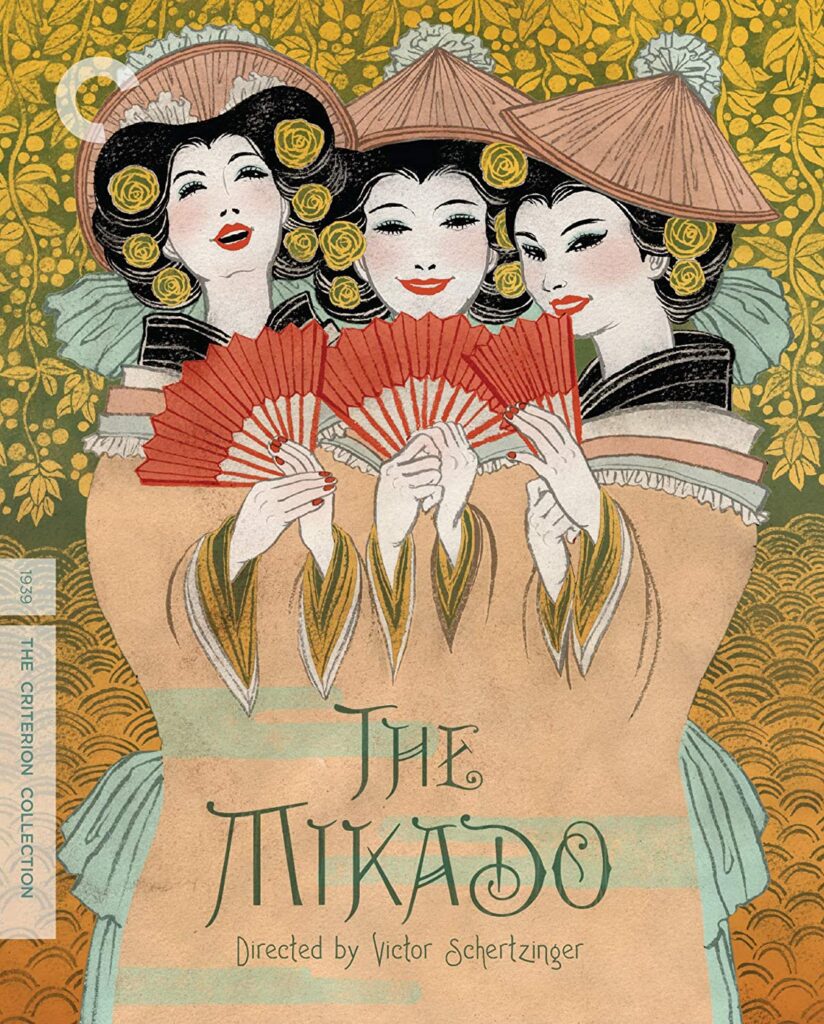
The Mikado is the ninth opera created by the tandem of W.S. Gilbert and Arthur Sullivan. It debuted in London on March 14, 1885, at the Savoy Theatre, which was built by impresario Richard D’Oyly Carte, and was performed to great success by his D’Oyly Carte Opera Company, leading to one of the longest theatrical runs of the era. In 1939, director Victor Schertzinger released an adaptation The Mikado in conjunction with the D’Oyly Carte Opera Company, becoming the first of Gilbert and Sullivan’s work made for the silver screen
The film begins with a prologue not in the opera to help set the story for the audience. Nanki-Poo, the son (Kenny Baker) of the Mikado (John Barclay), is betrothed to the older and unattractive Katisha (Constance Willis) against his wishes. He is told he must marry her or it’s off with his head, so he runs off and becomes “A Wand’ring Minstrel I”.
In Titipu, Nanki-Poo falls in love at first sight with Yum-Yum (Jean Colin), the ward and future wife of Ko-Ko (Martyn Green) the Lord Executioner, though he only has the title in name and not deed because he hasn’t killed anyone. The local authorities in an effort to thwart the Mikado’s decree that flirting be punishable by death installed Ko-Ko who was next in line for execution. Since he couldn’t kill himself, everyone in Titipu is free to flirt to their heart’s content.
However, matters get complicated, and the story gets bizarre and slightly unbelievable, when the Mikado demands an execution take place within a month or the town will suffer. Distraught over his inability to marry Yum-Yum, Nanki-Poo decides to commit suicide, which Ko-Ko decides to use to his advantage. In exchange for his suicide, he will allow Nanki-Poo marry Ko-Ko for a month. He agrees, but then things they run into a couple of how-de-do’s when Katisha comes to town looking for Nanki-Poo and rules about widows of suicide are discovered.
The Mikado is dated but has its charms. Seventy years later, everyone playing in yellowface takes a few moments to get used to, but it’s acceptable given that no malice towards the Japanese is evident and most of the satire is directed at governmental leaders and bureaucracy. The creators of the opera and the film present an idea of Japan without appearing to have any knowledge of Japan. Still, the cast gives their all in the performances. Martyn Green and Sydney Granville (as the multiple appointee Poh-Poh) are the highlights, so it’s no surprise they played the same roles in the D’Oyly Carte 1935 Tour. Hollywood’s Baker is the weakest link, a bit stiff as the lead and he made his character a bit bland. The production design crew created very impressive looking sets and costumes that are exquisitely captured by director of photography William V. Skall, who made a name for himself with his Technicolor work.
The video has been given a 1080/AVC MPEG-4 encoded transfer at an aspect ratio 1.33:1. The colors are very vibrant, particularly the greens and reds as expected from Technicolor. Pastels display bright hues, and blacks are solid. Details are sharp and well rendered from Katisha’s moustache to the fine textures of the costumes. Softness is seen in the frame, likely do to the way the over-70-years-old source was photographed.
A healthy amount of grain is evident but it’s never intrusive. While the standard systems for Criterion, MTI’s DRS, Pixel Farm’s PFClean, and Digital Vision’s DVNR, was used to clean the image. There were some sleight instances of dirt and a light flicker on right side of the screen.
The audio is LPCM Mono. Dialogue is clear and there is a perfect balance with vocals and music, an important matter for an opera. Bass instruments get adequate treatment through the subwoofer. No noticeable wear was heard on the track.
Special Features, in HD unless noted, are:
- ”Mike Leigh” (18 min) — Recorded in 2010, the director Mike Leigh, whose Topsy Turvy, is about Gilbert and Sullivan mounting the opera’s debut, offers insight into this film.
- ”Scholars” (29 min) — two interviews by Mikado scholars are edited together as they discuss the opera’s history and different stagings. Josephine Lee is an author and professor of English and Asian American Studies of the University of Minnesota, Twin Cities. Ralph MacPhail Jr. is Theatre Emeritus at Bridgewater College and the artistic and stage director for the Gilbert & Sullivan Society of Austin, TX.
- ”D’Oyly Carte Promo” (4 min) — A 1926 short, exclusive to the Mirror, revealing new costumes in The Mikado by Charles Ricketts, who is seen working on sketches.
- ”Deleted Scene” (3 min) — Ko-Ko’s “I’ve Got a Little List,” which details which undesirables could be executed, was shot but cut from the film. The phrase “nigger serander” likely influenced the decision as well as an odd sight gag regarding Hitler.
- ”The Swing Mikado and The Hot Mikado” (audio, 13 min) — Jazz versions of the opera appeared on Broadway, the latter produced by Mike Todd and featured Bill “Bojangles” Robinson. From Swing, there is “Three Maids from School” and “The Flowers That Bloom in Spring”. From Hot, there is “Willow, tit-willow” and Medley: Mikado’s Entrance/”A More Humane Mikado”.
Schertzinger’s The Mikado is an enjoyable melding of opera and film that offers a glimpse back in time at the sitcom of its day when the plot machinations are taken into account. Criterion does its typical well-done job with the film’s restoration and by delivering extras that provide context about the material for the viewer.